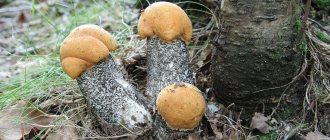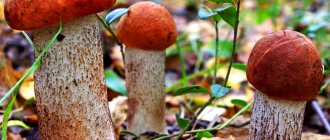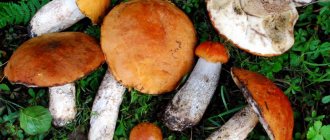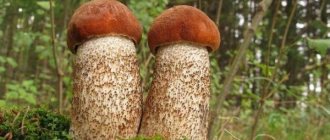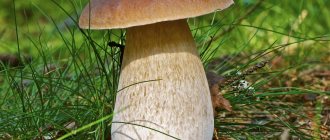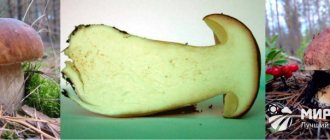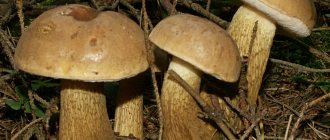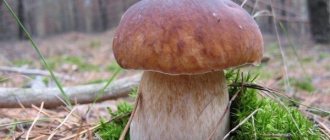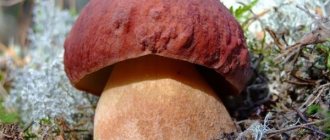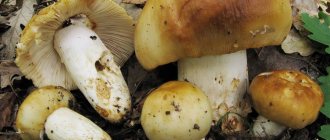White boletus is an edible and tasty mushroom listed in the Red Book. It can be eaten in various forms - raw or fried, pickled or dried.
Often found in pine or mixed forests. The best habitat is humid zones, and in dry areas - shady aspen forests. Acts as a rare mushroom, but very rarely appears in large groups.
Brief description of edible mushroom
Boletus or White Aspen is classified as a member of the genus Leccinum, of the Boletaceae family. It bears the Latin name Leccinum percandidum, there are also several synonyms - Boletus percandidus, Leccinum aurantiacum, Boletus versipellis and Krombholzia rufescens.
The cap grows in diameter up to 15 cm, less often reaches 25 cm. It has a cushion-shaped shape, the color is white with a pink tint, brown or blue-green. As it ages, it acquires yellow tones. The skin is dry, bare, felty.
The hymenophore or lower part of the cap consists of finely porous tubes, white or yellow in color; older specimens become gray or brownish in color. The spores are brown and ocher.
The pulp is white, quite dense, blue-green closer to the base of the stem. When cut, it quickly turns blue, then black, and acquires a purple color.
The leg is tall, can reach 15 cm, and in diameter no more than 4 cm, its shape thickens downwards and resembles a club. The color is white, covered with scales, which over time become gray or brownish and have a fibrous structure.
This is such a rare guest in the mushroom picker’s basket that it is listed in the Red Book of Russia, as well as most regional ones where it grows. Prohibited for collection.
How to collect
The white boletus, its first representatives, appears in early June and continues to delight lovers of quiet hunting until the end of September - beginning of October.
For the formation and growth of the fungus, the presence of sufficient moisture is extremely important. During the wet, rainy period, white boletus grows abundantly on the roots of its partner trees. A mushroom picker who sets out at this time will return home with rich trophies.
Where is white boletus collected? In dry times, it can only be found near aspen trees, since there it can provide itself with the necessary moisture. The lifespan of the fungus is short, only two weeks, after which it sows spores and dies.
Although white boletus retains its pulp density and high taste for a long time, young mushrooms are the best choice. In addition, older specimens are more susceptible to attack by insects and pests.
When harvesting white boletus, it is very important not to damage the mycelium, so that it will continue to please lovers of quiet hunting with a harvest. Therefore, you should use a sharp knife for cutting. You can also gently shake the mushroom first and then turn it out.
You should also note that mushrooms tend to accumulate all kinds of toxins and heavy metals from the soil. Therefore, for collection you need to choose environmentally friendly places, away from industrial enterprises, roads, etc.
Time and place of fruiting
It prefers pine forests mixed with spruce or other trees; in dry times it hides in damp places in aspen forests. Found in birch forests. Fruiting lasts from June to September.
It is quite rare, but sometimes large families of white boletus can be found. On the territory of Russia it is found in the Murmansk and Penza regions, as well as in the republics of Mari El, Komi and Chuvashia.
Known in the Moscow and Leningrad regions, as well as in eastern Siberia, in the Arkhangelsk region. This mushroom is also found in the southwestern territory of Lake Baikal and the territories of Khanty-Mansi Autonomous Okrug and Yamalo-Nenets Autonomous Okrug.
Finds of white boletus are known in Estonia, Belarus and Latvia, as well as in western Europe and North America.
Eating white boletus
This species is used in the same way as other edible varieties of boletus. Young specimens are stewed, fried and boiled, and canned, including in combination with all kinds of vegetables. This side dish can perfectly complement almost any dish.
Mature mushrooms are not of particular culinary value, but they are the best ingredient for preparing all kinds of medicinal decoctions, infusions, as well as dry raw materials for the winter.
Growing at home and in the country
White boletus is a tasty, edible mushroom that gets along well in a prepared garden plot. To plant it, you will need to purchase mycelium, which is enough for 3 square meters. m. under one tree or bush. Planting process:
- The area at the roots of the plant is dug up and a depression of up to 15 cm is created.
- The mycelium is evenly distributed over the entire area of the pit.
- The top needs to be covered with garden soil mixed with humus in equal proportions.
- Cover with the remaining soil from digging a hole.
Any trees are suitable for planting; the mycelium will take root regardless of the time of year (in the southern regions it can be planted in winter). Water with a regular garden watering can; the planted area will need 30 liters of water.
The first harvest can be observed in autumn or spring, but not earlier than 5 months later. After planting, most often the first fruits can only be harvested the next year.
From a planted plot it is possible to collect about 1.5 kg in the first year and up to 14 in the next. Mushrooms will delight as long as the tree lives.
Growing methods
White boletus can be grown in any summer cottage. To do this, certain methods are used:
- Growing with spores: for this, the caps of overripe mushrooms are prepared. They are filled with water and left for a couple of hours. The resulting liquid is watered over the area prepared for planting.
- Planting with crushed parts of fruiting bodies: young mushrooms are well crushed and buried in the soil near the trees on the site.
- Using ready-made mycelium: it is sold in gardening stores, there are several options. Planted and cared for according to the instructions included with the bagged mycelium.
False doubles
Science does not know any false species of boletus, but many inexperienced mushroom pickers can confuse the tasty edible fruit with bitterling. It is very easy to distinguish it from white aspen - it is yellow. The surface of the cap and the stem itself have beige shades, while white boletus can have grayish shades even at an old age.
The boletus turns blue when cut, and the bitterling becomes pink or reddish.
Gorchak
What is the difference between porcini mushroom and boletus?
The porcini mushroom is easy to distinguish from the white boletus, because its cap will be light brown in color, and sometimes with a reddish tint.
The pulp does not change color when cut, unlike aspen, and the stem is slightly thicker. The boletus has a special mesh pattern on the stem, by which it is easy to distinguish.
In terms of taste, boletus is somewhat inferior to boletus, and its flesh is a little harder. The porcini mushroom also has dense flesh, but it is juicy and meaty, which cannot be said about the boletus.
Porcini
Related species
Boletus is a group of species of mushrooms of the genus Leccinum (boletus). In addition to boletuses, this genus includes a group of boletuses. Representatives of both groups are edible mushrooms.
The main distinguishing features of boletuses are:
- the flesh turns blue when cut;
- the leg is thicker, stockier;
- the flesh of the cap is denser.
In addition to the white boletus species, more than a dozen species are classified as aspen boletuses. The most common:
- red boletus – Leccinum aurantiacum;
- red-brown boletus (yellow-brown) – Leccinum versipelle;
- black-scaled boletus – Leccinum atrostipiatum;
- oak redhead – Leccinum quercinum;
- redhead pine – Leccinum vulpinum;
- red spruce grass – Leccinum piceinum;
- colored-legged boletus – Tylopilus chromapes (Leccinum chromapes).
Evaluation of taste qualities, medicinal properties, benefits and possible harm
White boletus is an edible fruit that belongs to the second category. It is believed that it is better to pickle young fruiting bodies, and it is preferable to fry or dry more mature specimens. This mushroom is dried, frozen, salted, and it also goes well with other relatives in one dish.
Among the beneficial properties are:
- ability to purify blood;
- removal of harmful substances from the body, it works as an absorbent;
- ability to lower cholesterol;
- restoration of immunity;
- sedative properties;
- tissue regeneration;
- restoration of intestinal microflora.
In addition, boletus helps in the treatment of cancer.
Attention! Mushrooms are prohibited for children under 3 years of age, pregnant and lactating women. Use with caution if you have diseases of the stomach, liver and intestines. Individual intolerance and gout may be prohibited.
A large number of tinctures are prepared from white boletus; it is especially popular in folk medicine. Using the product will help cope with the following diseases:
- atherosclerosis;
- oncology;
- dysbacteriosis;
- depression, nervous tension;
- restoration of immunity;
- anemia, improves complexion.
To prepare the tincture you will need:
- white boletus caps;
- vodka or Cahors;
- glass jar.
The parts of the mushroom are cleaned and washed, cut into small pieces, placed in a jar, then filled with the selected alcohol composition. The sealed container is placed in a dark place for 15 days. After this, the resulting mass should be filtered and drunk 3 tbsp. l. in a day. The course of treatment is up to 3 months.
Chemical composition
Nutritional value depends on the chemical composition of white boletus. The plant contains mono- and disaccharides, amino acids, including essential, unsaturated fatty acids, etc. Vitamins A, E, C, B1, B2 (0.4 mg), PP (up to 10 mg) are also present.
Macro- and microelements in the composition of white boletus make up about 1.5% and are represented by the following: potassium (404 mg), phosphorus (90 mg), magnesium (16 mg), sodium (6 mg), calcium (3 mg), iron ( 0.3 mg), potassium, etc.
Important! The information presented in the material is for informational purposes only. Before use, be sure to consult a specialist.
Yellow-brown boletus (Leccinum versipelle)
Synonyms:
- Obabok is multi-skinned
- Red-brown boletus
Cap: The diameter of the yellow-brown boletus cap is 10-20 cm (sometimes up to 30!). The color varies from yellowish-gray to bright red, the shape is initially spherical, no wider than the leg (the so-called “chelysh”; it looks, as you understand, quite feydish), later convex, and occasionally flat, dry, fleshy. At the break, it first turns purple, then acquires a bluish-black color. It has no special smell or taste.
Spore-bearing layer: Color from white to grayish, pores are small. Young mushrooms are often dark gray, becoming lighter with age. The tubular layer is easily separated from the cap.
Spore powder: Yellow-brown.
Leg: Up to 20 cm long, up to 5 cm in diameter, solid, cylindrical, thickened towards the bottom, white, sometimes greenish at the base, going deep into the ground, covered with longitudinal fibrous scales of gray-black color.
Distribution: Yellow-brown boletus grows from June to October in deciduous and mixed forests, forming mycorrhizae mainly with birch. In young forests it can be found in fabulous quantities, especially in early September.
Similar species: There is no final clarity regarding the number of varieties of boletus (more precisely, the number of species of mushrooms united under the Russian name “boletus”). Particularly noteworthy is the red boletus (Leccinum aurantiacum), which is allied to the aspen, which is distinguished by red-brown scales on the stem, a not so wide span of the cap and a much more solid constitution, while the yellow-brown boletus is more reminiscent of the boletus (Leccinum scabrum) in texture. Other species are also mentioned, distinguishing them mainly by the type of trees with which this fungus forms mycorrhiza, but here, obviously, we are still talking about separate subspecies of Leccinum aurantiacum. Edibility: Excellent edible mushroom. Slightly inferior to white.
Notes We all love boletus. The boletus is beautiful. Even if he doesn’t have such a powerful “inner beauty” as the white one (although he still has some), his bright appearance and impressive dimensions can please anyone. For many mushroom pickers, the boletus is associated with memories of the first mushroom - the first real mushroom, not the fly agaric or the russula. I remember very well how, back in 1983, we went for mushrooms - at random, not knowing the places and the route - and after several unsuccessful forays we stopped near a modest young forest at the edge of a field. And there!..
I think you already guessed what we saw there. What and how much... And that the spare tire had to be dragged from the trunk into the passenger compartment, because there was no room there, you also guessed... And that the car was so overloaded that it scraped the asphalt with its belly, I won’t lie. But there were simply an indescribable mass of boletuses there! Boletuses and for some reason little boletuses. In the proportion of “one boletus per two boletus”. And there was a good bucket of waves with a small
Moreover, please note that the waves are still small
Eh!.. And where are these times? Thanks to their naive catchiness, boletuses are the first to leave our forests. In marching order, folding the banners...
False boletus - description and photo. How to distinguish boletus?
The boletus mushroom is not only one of the most beautiful mushrooms, but also the safest. Almost all boletuses, without exception, are edible, and knowing the mushrooms by sight, you can safely collect them without fear of poisoning. Although cases of poisoning from raw and cooked boletuses have been reported in North America, there is currently no definitive information on which boletus species growing in America are poisonous.
And yet, mushroom pickers have questions about whether there is a false boletus, what it looks like and how to distinguish an edible boletus from a false one. In fact, there are no false boletuses. The only thing is that the boletus can be confused with the gall mushroom (gorchak), which, in principle, does not look like a real boletus.
The gall mushroom has a bitter taste, turns pink or brown when cut and has a brown mesh on the stem. Boletus has a pleasant taste, black scales on the stem and turns blue when cut.
Below is a photo of an inedible gall fungus. Read more about how to distinguish gall fungus in this article.
Bile mushroom
general characteristics
Based on the name, you can understand that the main place where the fungus grows is in areas under aspen trees. However, this species is also found in mixed forests, as well as in birch-aspen groves.
Popular articles Why doesn't camellia bloom?
However, the mycelium is still more associated with aspen. It is in these shady and damp places that the boletus mushroom is most often found in groups or individually.
There are many varieties of this forest dweller. All of them are edible, but there are false boletuses that imitate them. They have a number of distinctive features.
Boletus mushrooms belong to the Boletaceae family. The first of them appear in June (when the fluff begins to fly off the aspen trees). But their first season is short. The second season is mid-July, it is already longer than the first. The third season lasts from the end of October until the first frost.
Types of these mushrooms, appearance
Boletuses (Latin name Leccinum percandidum) are edible mushrooms that have a thick stem and a dense cap. White boletus is one of eight existing species. In nature, red, white, yellow-brown, painted-legged, pine, oak, black-scaled and spruce boletus are found.
White boletuses have a rather large hemispherical cap. The cap is white, but sometimes found with pinkish, brown or blue-greenish hues. The aspen mushroom has a dry and bare skin. The leg is tall, also white, covered with fibrous scales. As they age, the scales may change color from white to gray or brown. The pulp is white, looks strong, turns blue when cut, then turns black, and turns purple on the stem.
Symptoms of poisoning
You already know what a porcini mushroom is, when to collect it and where. However, it is necessary to understand what symptoms occur during poisoning and what to do in this case. As practice has shown, the first signs appear no later than two hours after consumption.
In case of poisoning, nausea, vomiting and severe diarrhea occur. The temperature rises to almost 40 degrees, and the hands and feet become very cold and chills begin. In some cases, hallucinations are noticeable.
At the first signs of poisoning, you should take activated charcoal, drink as much cold water and strong, chilled tea as possible. In the meantime, you need to call a doctor or an ambulance. Only with proper and timely treatment does a person have the opportunity to recover within three days.
How long does the boletus grow? When to collect?
Boletuses occupy a leading place in terms of growth rate. For example, a mushroom can grow a couple of centimeters in a day. Weather conditions affect the growth rate of boletuses.
After a heavy rain within a day, they become quite impressive in size, since they quickly absorb moisture from the soil and all useful substances. By the way, the absorption of harmful substances by mushrooms also occurs, so it is very important to collect them only in environmentally friendly areas.
Interesting fact: the lifespan of mycelium (mycelium) reaches 80 years. In order for boletuses to grow in the same place repeatedly, they should be collected carefully.
If it rains frequently, then the collection of redheads can continue throughout the summer and autumn until it gets colder. After the rain, just wait a day - the mushrooms will already have reached the desired size. If cold weather persists, the red mushroom takes 3-4 days to reach its optimal size.
In cooking
The white boletus, just like its more famous relative the red boletus, is a universal mushroom and is suitable for all types of culinary processing: it is boiled, stewed, fried. It has proven itself well both as a component for preparing dishes and as the basis of a culinary masterpiece. Recipes for white boletus can be safely borrowed from red boletus.
The mushroom has a unique mushroom taste and aroma, which in the finished dish is revealed to the maximum and becomes more delicate and refined. Pairs well with other boletuses.
Soups are prepared from boletus, and fried mushrooms with boiled potatoes are delicious (large mature specimens can be used for frying). Dishes with white boletus will decorate any holiday table.
Boletus mushroom: other features
Despite the relative “nobility” of boletuses, safety measures cannot be neglected when collecting them. Compared to the same butter mushrooms, these mushrooms absorb harmful substances much less. But they, like white ones, can also accumulate radionuclides (cesium, etc.) and become toxic. And in radioactively hazardous areas it is better to completely abandon “silent hunting” for any mushrooms. In addition, to prevent poisoning (especially when harvesting for future use), boletus mushrooms should be boiled in salt water and vinegar several times (2-3) for 30 minutes before cooking, changing the water each time.
{SOURCE}
Preparation of boletus mushrooms and cooking recipes
You can do whatever you want with boletus mushrooms. These mushrooms are dried, salted, pickled, fried with potatoes, and frozen. First, they need to be thoroughly cleaned.
- Drying. You need to choose large mushrooms. No need to wash, just wipe with a damp cloth. Cut the cap and stem into strips, about 1 cm thick. Place on a mesh. Small mushrooms – these can be dried whole and look amazing in soup. If there is no drying, then simply expose it to dry, hot weather; the process will not be quick, it may take a week. But the result will be a natural product, dried in a natural way. In bad weather, you can bring it into a well-ventilated area. This product in dried form is unique. The soup made from these mushrooms turns out rich and aromatic. This result cannot be achieved with fresh mushrooms.
- Freezing. The mushrooms must be thoroughly washed, cut and boiled in a saucepan for 40 minutes. Drain the water using a colander, cool, portion into bags and freeze. Can be stored for no more than two years.
- Salted boletus. Rinse the caps thoroughly and boil for 20 minutes. Place in a container, sprinkle with salt, place horseradish leaves and dill on top. Pour boiled water. You will need 2 cups of salt per bucket. Consume this snack no sooner than after a week, but you should not keep it for more than a month. The brine may darken, do not be alarmed.
- Pickled boletus. Wash the mushrooms and cut off the caps. There are housewives who have waste-free production, and they even scrape the legs, freeing them from scales. Boil the mushrooms for about 35 minutes, add spices. Everything here is to taste: salt, pepper, seasonings, bay leaf. Boil for another 5 minutes. Pour into jars and roll up. If you don’t want to get mushrooms in dark brine, you need to boil the mushrooms for 30 minutes and drain the water. Prepare the marinade, place the mushrooms in it and simmer for 10 minutes.
- Mushroom caviar. This is a very tasty and healthy dish. In addition to mushrooms, caviar contains many healthy vegetables. Wash the mushrooms, boil them, and grind them through a meat grinder. Separately fry onions, carrots, bell peppers. After frying, also pass through a meat grinder, combine with mushrooms and simmer for 20 minutes. Add spices to taste. Roll up.
- Boletus salad. Boil the mushrooms, cool. Cut into small pieces. Cut the pickled cucumber and boiled chicken breast into cubes. Mix with mushrooms, add mustard, season with mayonnaise and add salt. Celery – will add piquancy to the dish, but this is not a necessary product.
In addition to the above options, boletuses can be stuffed, made with spaghetti, or simply served as an appetizer for the holiday table. Use when making pizza and pies.
Distinctive features of the boletus mushroom
A typical boletus mushroom has a wide (up to 5 cm in diameter) stalk that sits deep in the ground. As it grows, it stretches up to 20 cm in height and remains cylindrical (or slightly conical). But it does not thicken like porcini mushrooms. The cap of a young specimen (the so-called “babe”) usually looks tightly “put on.” It has strongly pressed edges and a short stem. But the mushroom itself at this age faintly resembles an adult boletus. Subsequently, the leg begins to grow faster, and the cap - a little slower. Because of this, its dimensions do not seem quite appropriate.
From the middle age of the mushroom, the cap grows more actively, unfolding to an average of 15–20 cm in diameter. As a result, it takes on either a hemispherical or pillow-shaped shape. In the largest adult specimens, it can even take on an almost inverted appearance, like that of a moss fly. The hat, as a rule, has a dry, matte, velvety surface to the touch. And in the lower part there is a white or light gray finely porous tubular layer (in young mushrooms). It becomes dark gray or grey-brown with age and turns black when pressed.
One of the expressive signs of boletus is considered to be the absence of a ring and the presence of a “pattern” on the stem. The latter forms small burrs-scales directed upward, capturing and holding moist soil as the fungus emerges to the surface. Because of this, mushroom stems sometimes even seem velvety to the touch. Depending on where the mushrooms grow, the scales may have different shades. This often helps to more accurately identify the species. However, it must be borne in mind that this sign is very unstable. The fact is that aspen boletuses growing on slightly moist, loose soil may not have a characteristic pattern on their legs at all.
Is it possible to eat porcini mushrooms?
The white-capped boletus is edible and poses no threat to humans. The pulp is rich in fiber, vitamins and amino acids, which are well absorbed by the body. White aspen belongs to the mushrooms of the second food category. This includes edible varieties with good taste. In terms of nutritional quality, they are second only to porcini mushrooms, milk mushrooms and chanterelles.
Boletuses help strengthen the immune system, which is especially important when recovering from illness. The substances contained in the pulp have a positive effect on the composition of the blood and support the functioning of the heart. Regular presence of this species in the diet helps remove waste and toxins from the body.
Before use, boletus is soaked in water and then boiled. After processing, toxins are released from the pulp. The product is not used in its raw form. The resulting mass is used for further cooking or frozen for the winter.
Various homemade preparations are obtained from the white variety. Marinated boletus mushrooms retain their good taste and serve as an excellent appetizer. Fruit bodies are also pickled hot or cold.
Advice! The product has a low calorie content - up to 22 kcal per 100 g. It is recommended to include it in the diet. Boletus can be consumed by people suffering from diabetes.
Beneficial features
Such mushrooms contain a large amount of useful substances - they are enriched with:
- proteins and carbohydrates;
- fiber and fats;
- a wide range of minerals;
- potassium and iron;
- phosphorus and vitamin complexes;
- essential amino acids.
White boletus is recommended for consumption by those who suffer from inflammatory diseases and anemia. It also takes part in the healing of wounds and restoration of the body after infectious diseases.
However, if you have kidney or liver problems, it is best to avoid eating this mushroom. It is worth noting that old individuals can provoke poisoning.
This mushroom should not be given to children, and long-term storage in the refrigerator should be avoided - in this case, it loses its beneficial properties and quickly ages, which in any case poses a danger to people.
How to process
White boletus is a mushroom that requires certain preliminary preparation before the main culinary processing.
- The mushrooms are carefully sorted, discarding rotten and wormy specimens.
- Using a sponge, clean off dirt, soil, forest debris, etc.
- Rinse thoroughly in running water. White boletus can be soaked, but not for long, as it tends to absorb water, and if soaked for a long time, the pulp becomes too soft, loose and unsuitable for food.
- Then you need to use a knife to carefully scrape off the scales from the legs.
- The next mandatory step is boiling (of course, this is skipped when drying). There is no need to pour out the white boletus decoction; you can use it to make a delicious mushroom soup.
- The disadvantages of white boletus include the fact that after any processing, with the exception of pickling, it darkens, which is not a sign of spoilage. Its taste properties remain unchanged. This can be avoided by first soaking the prepared mushrooms in a 0.5% (0.5 g per 1 liter of water) citric acid solution.
Collection time
The fruiting time of boletuses is conventionally divided into periods.
The first mushrooms appear in the summer, and they are called spikelets. Already at the end of June you can meet the firstborn in the forest. But you shouldn’t count on their abundance. There are few of them at this time.
From mid-July to September is the time for the stubble plants to bear fruit. A bountiful harvest of boletus at this time will please any mushroom picker.
Deciduous plants can be found until the October frosts. Their period begins in mid-September.
Storage conditions
The boletus mushroom is in no way inferior to the boletus mushroom in its taste and nutritional properties; rather, it shares the second place of honor with it after the porcini mushroom. Boletuses are boiled, fried, dried, pickled, salted, using both the cap and the stem (although some consider it a bit harsh). During processing, Boletus, as a rule, darkens, only in the marinade does it retain its natural appearance.
Drying
Clear the boletuses from twigs, grass and soil. Boletus mushrooms must not be washed before drying! Mushrooms take on water very quickly, and washed mushrooms cannot be dried. Small boletuses are dried whole, large ones are cut, but not finely.
It is best to dry on a thread or in the oven. The oven temperature should be set at 50-60 degrees - this is the minimum available mode and the door is slightly open. Some oven models will require you to open the door completely due to the inability to lower the temperature. Dry the mushrooms on a baking sheet lined with parchment. Place on the top shelf.
